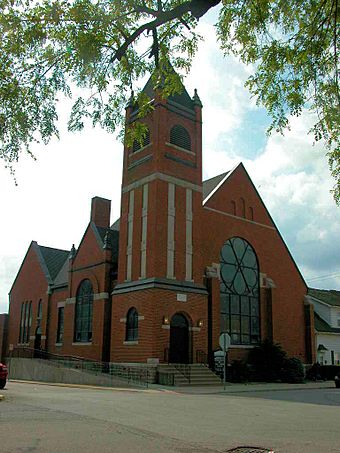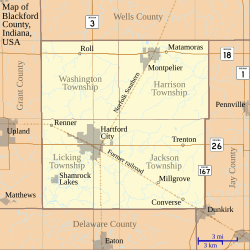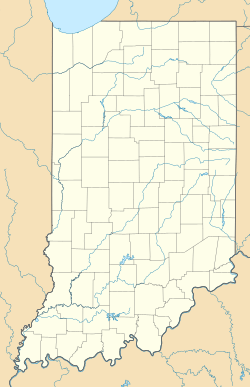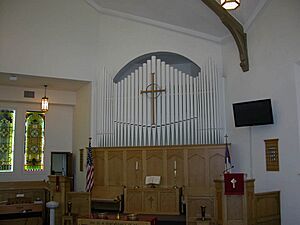First Presbyterian Church (Hartford City, Indiana) facts for kids
Quick facts for kids |
|
|
First Presbyterian Church
|
|

Hartford City's First Presbyterian Church in 2010
|
|
| Location | Hartford City, Indiana |
|---|---|
| Built | 1893 |
| Architect | Alec Gable |
| Architectural style | Romanesque |
| NRHP reference No. | 86001263 |
| Added to NRHP | June 13, 1986 |
The First Presbyterian Church in Hartford City, Indiana, is a historic Presbyterian church building. It is the oldest church building in this small city. Hartford City was once a busy place with many glass factories and businesses.
The church is located at the corner of High and Franklin Streets. It is part of the Hartford City Courthouse Square Historic District. The church was added to the National Register of Historic Places in 1986. This means it is a special building worth protecting.
Construction of the church started in 1892 and finished in 1893. The building is a great example of the Richardsonian Romanesque style of architecture. One of its most amazing features is its huge stained glass windows. These windows were made by hand in Belgium and put together by local glass workers from that country.
When the church was built, the area was growing fast. This was because natural gas had been discovered nearby. This time is known as the Indiana Gas Boom. Many of Hartford City's unique buildings were built during this period. This includes the Blackford County Courthouse and the First Presbyterian Church. Both are listed on the National Register of Historic Places.
Contents
Presbyterians in Hartford City
In the 1840s, the community that became Hartford City was just called Hartford. Methodists had already been holding church services there since the 1830s. A second Christian group, the Presbyterians, started in the area on December 18, 1843. Thirteen people and Reverend Samuel N. Steel founded the Presbyterian Church of Hartford.
The first Presbyterian church building was built in 1844. It was on Mulberry Street, on the edge of the small farming village. The church was briefly renamed Blackford Presbyterian Church in 1853. But by 1855, it was called the Presbyterian Church of Hartford again.
Today, the original Mulberry Street location is about two blocks from the current courthouse square. Hartford was renamed Hartford City in the 1850s. This happened because another town in Indiana was already named Hartford. The community grew and became an official town in 1857.
The Presbyterian congregation also grew. Important families in the county, like Willman, Gable, and Reasoner, were members. As the church became too crowded, the women of the congregation started raising money for a new building.
On March 7, 1868, the Presbyterians bought a new lot for $150. It was on the north side of Hartford City, at High and Franklin Streets. A new wooden church was quickly built there. Church members and friends helped build it for free. This new church was bigger and nicer. It was heated with two stoves.
However, within 20 years, it became too crowded again. Members didn't want to go into too much debt for a new building. But they started working to save money for a larger church. The women of the church played a huge role in fundraising. They organized many projects and clubs, like the Sewing Circle and the Aftermath Society.
In 1883, a new group called "The Woman's Home and Foreign Missionary Society..." was formed. It started with 6 members but quickly grew to 80 members and guests. This was a lot of people, considering the whole town only had about 1,470 residents in 1880.
Building the New Church
In 1890, Reverend A. Judson Arrick became the new pastor. He encouraged members to raise even more money for a new church. Eventually, plans were approved, and Alec Gable was chosen to build the new brick church.
In 1892, the old wooden church was moved one block east to Jefferson Street. This cleared the way for the new church to be built at Franklin and High Streets. The cornerstone for the new building was laid that same year. Sadly, Reverend Arrick left Hartford City in September 1892 and didn't see the church finished.
By December, the roof was on and the floor was laid. Church members held their first service in the partly finished building on January 8, 1893. Reverend J. W. Fulton was the new pastor.
The new church was completed by July 1893. A special dedication ceremony was held on July 9, 1893. Many people attended, including visitors from other towns. At the ceremony, it was announced that $5,000 was needed to pay off the building's debt. People pledged $4,809 that day. By the end of the evening, over $5,500 was donated. This meant the church was completely free of debt!
The building cost over $10,000, which was a lot of money back then. But the congregation's hard work paid off with a beautiful, debt-free church. The church had two main rooms: the sanctuary on the west side and a lecture room on the east side.
The old wooden church was not forgotten. It was rented out for a few years and used for storage. Before 1895, it was moved again to the south side of town. There, it became a mission Sunday School, with 30 to 40 students attending each Sunday.
Church Design and Style
People in Hartford City were very impressed with the new church. A local newspaper said it was "a monument of which they may be justly proud." The church is considered the best example in Hartford City of the Romanesque Revival architectural style known as Richardsonian Romanesque.
This style became popular in America in the late 1800s. It was often used for churches and public buildings. Key features of this style include a large single tower, round arches over windows and doors, groups of windows, gabled roofs, and different colored stone or brick on the outside.
Alec Gable, the architect, used many of these features in the church's design. The outside of the building is brick with limestone trim. This mix of textures is typical of the Richardsonian Romanesque style. Indiana is famous for its limestone, used in many famous buildings across the U.S.
The church's main front (façade) has a gabled roof, a round-arched doorway, and a large stained-glass window. A square bell tower is on the northwest corner. The top of the tower is steep and pyramid-shaped, with a Christian cross on top. These are also common in Richardson's designs.
The west side of the church, facing High Street, has the main entrance to the sanctuary. It features a huge stained glass window with narrow brick supports called buttresses. The circular window, called a rose window, is like those found in old European cathedrals.
The north side of the building, facing Franklin Street, has two gabled sections. One section next to the bell tower has a large stained glass window. Both large windows (west and north) can be seen from inside the church's sanctuary.
Amazing Stained Glass Windows
One of the most important parts of the 1893 church building was (and still is) a huge stained glass window on the High Street (west) side of the sanctuary. For over 50 years after it was put in, people thought it was the largest window in one frame in Indiana.
Mrs. George Gable paid for this stained glass window. It was a memorial to her mother, Lydia Taughinbaugh, who was one of the church's first members. The glass was made by hand in Belgium. Local glass workers from Belgium installed it. Many of Hartford City's Belgian glass workers were Catholics who lived on the other side of town.
In 1892, Hartford City Glass Company was the only glass factory in town. So, it's likely the Belgian glass workers were employees there. Belgium was the world's top exporter of glass in the 1800s. They were known for making excellent flat glass.
The stained glass windows in Hartford City's Presbyterian Church still have incredibly bright colors. These colors are hard to make today. In the past, the "recipes" for glass colors were often kept secret. Knowledge was passed down from master to student. The exact color depended on secret ingredients, how long the glass was heated, and even the pot it was made in. Some ingredients used to color glass are no longer used because they were found to be dangerous!
In the Middle Ages, stained glass windows and other art in churches often helped teach people who couldn't read. This art was sometimes called a "Poor Man's Bible." Some windows showed scenes from the Christian Bible, while others used symbols to represent its teachings. The many stained glass windows in Hartford City's Presbyterian Church continue this tradition with both Bible scenes and symbolism.
The huge window on the church's west wall looks like a fancy geometric design. But it is full of symbolism. The circular part at the top is a rose window. This type of window was popular in Romanesque and Gothic cathedrals. The west side is a common place for a rose window. This allows the afternoon sun to make the window look even more beautiful inside the church.
In the 1800s and 1900s, rose windows were often dedicated to Virgin Mary, the mother of Jesus. The center of the rose window in Hartford City's First Presbyterian Church has a gold ring. This represents Christ as the center "light." Around Christ are twelve objects, symbolizing the twelve disciples. Below the rose are four tall, narrow windows that represent the four gospel writers. This window, dedicated to a mother, follows tradition by being on the western side of the church.
While the west window has some feminine symbols, the other large window on the north side has masculine symbols. It shows a crown, symbolizing Jesus Christ the King. Other messages in the church's stained glass windows include:
- A simple nativity of Jesus scene with the Star of Bethlehem.
- A crown of thorns with a broken cross, showing the crucifixion of Jesus.
- The traditional Holy Grail, symbolizing communion.
The main west window uses mostly soft, muted colors like light blues and greens. These colors are unique and represent nature's beauty. The light blue tones show the sky and water, which bring rain to the earth. The muted greens show leaves and the life cycle in nature. These colors connect to the idea of oxygen and carbon dioxide exchange, and all organic life.
The blues and greens in the west window represent the story of creation in the Bible. They show how God created the heavens and earth, sunlight, air, and water to nourish the earth and grow plants. This organic life sustains human life. The north window confirms this meaning. It clearly shows the beauty of the oceans, which cover most of the earth. The oceans' process of evaporation and condensation creates all life on earth. Together, these windows tell a unique story of God-given science in nature.
Changes and Improvements
The new building made more people interested in the Presbyterian Church. Membership grew to 253 in 1895, and Sunday school had over 300 students. Over the first 100 years, small changes were made. For example, doorways were moved, and the sanctuary was changed. A door on the south side of the west wall, seen in old pictures, was removed early on.
One of the first changes inside was making the pulpit and choir platform bigger. This was to fit a larger choir. The platform was made even bigger in 1912 when the church bought a pipe organ.
In the 1920s, Sunday School attendance reached its highest point, with 500 students. Because of this, there was a plan to add a new building to the east side of the church. But people worried about debt, so a cheaper plan was chosen. This plan involved closing off the east lecture room. This happened in the early 1930s. The result was a balcony on the east side of the sanctuary and six classrooms. A few years later, in 1936, the sanctuary was completely redecorated.
The 1930s and 1940s were some of the busiest years for the church. Newer generations of the city's important families, like Emshwiller and Fulton, were still members. Many members also worked in the city's important glass industry. Membership reached 438 in the 1940s.
The last major change to the church building was in 1959. Construction began for an east wing. Today, the bell from the bell tower rests on the ground on the south side of the building. The bell was removed from the tower for safety reasons and to reduce stress on the tower.
The Pipe Organ
In 1908, Reverend George Sheldon became the new pastor. After a couple of years, he encouraged the church to get a pipe organ. Different church groups started raising money. Also, Andrew Carnegie, a famous philanthropist, donated $1,000.
The new pipe organ cost over $2,000. It was installed in 1912 after the choir and pulpit platform were made larger. Professor Isaac Norris of DePauw University played the dedication concert. Professor Carl Bilby of Muncie, Indiana was the first regular organist. This pipe organ is thought to be the first in the city and is still used today. The photo shows the church's pulpit and part of the pipe organ.
East Wing Addition
A two-story building with a flat roof was added to the east side of the church in 1960. It was named Westminster Fellowship Hall. Its purpose was for church gatherings and Christian education. Planning and fundraising started in the spring of 1958. This was the only large expansion of the church.
Construction began with a groundbreaking ceremony in August 1959. Dr. John W. Halsey, the pastor, and other members took turns with a symbolic shoveling of earth. The total cost of this addition was about $85,000.
The Church Today
As of 2008, the church had 122 members. Reverend David Smith was the pastor in 2010. While membership is lower than its peak before World War II, it had slightly increased from earlier in the 2000s. The city's population has gone down since the 1970s. This is partly due to problems in the American auto industry.
However, Hartford City's First Presbyterian Church is still "a monument of which they [the community] may be justly proud." The church holds services in the city's historic district, in a historic building. It stands on land bought in 1868. Located at the corner of Franklin and High Streets, much of the church building looks the same as it did when it was built in 1892 and 1893. The church has existed in three different centuries and continues to be an important part of the community.
See also
 In Spanish: Primera Iglesia Presbiteriana (Hartford City) para niños
In Spanish: Primera Iglesia Presbiteriana (Hartford City) para niños
- Presbyterian Church (U.S.A.)













